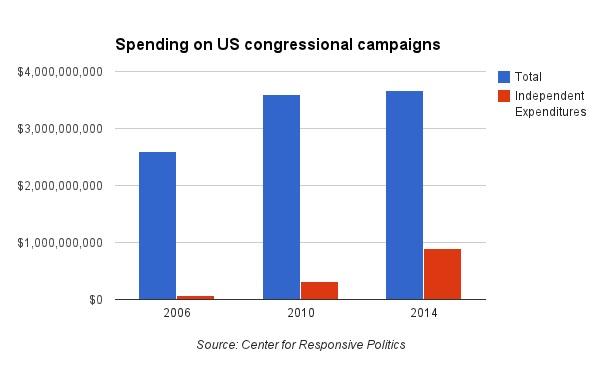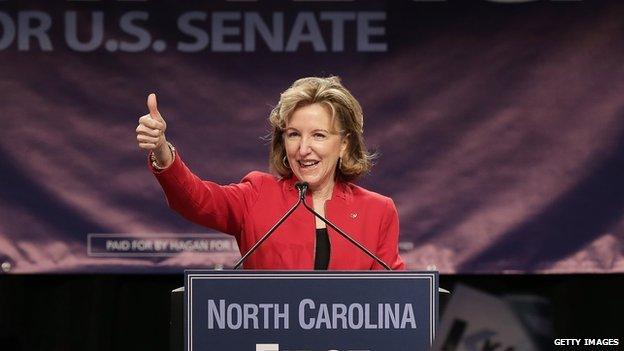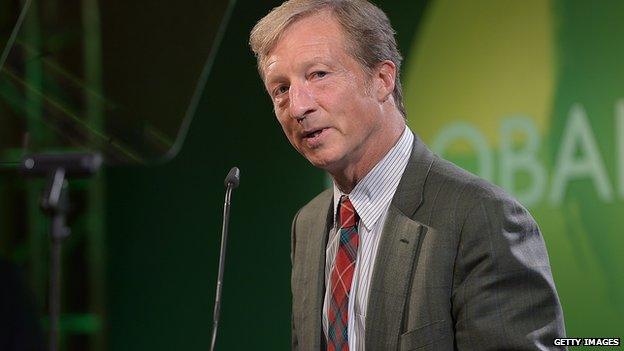Money in politics: More than a game
- Published
- comments
US midterms 2014: Where does all the money come from? (Video by David Botti)
Imagine the US map as a giant board game. Electoral Risk, let's call it
Scattered across the country are key territories to control - Georgia, Colorado, Iowa, Oregon. Instead of armies, players move stacks of money from state to state.
The objective is to help chosen political candidates tally wins when voters head to the polls on election day next Tuesday.
The prize is power - control of Congress and the ability to shape the agenda in Washington for years to come
Up until recently this game had a limited number of players. Leaders from the two major US political parties, Republican and Democratic, controlled the money and devised the strategy.
Thanks to legislation and Supreme Court decisions over the past 12 years, however, the game has changed entirely. The power of political parties ebbed, while outside groups and individuals have been given new freedom to buy seats at the game.
They can run advertisements and develop get-out-the-vote organisations just like the parties did. And unlike their Republican and Democratic counterparts, they often have no caps on the funds they can raise and limited requirement to identify exactly where the cash comes from.

The result has been an explosion of money into the political system. According to projections by the Center for Responsive Politics, $3.67bn, external (£2.29bn) will be spent on congressional elections this year, making it the most expensive mid-term election in US history. In addition, independent expenditures are taking a larger and larger share of that total.
The North Carolina Senate race offers a textbook example of how the new electoral rules are playing out.
Democrat Kay Hagan is seeking a second term in a state that was narrowly carried by President Barack Obama in 2008 and won by Republican challenger Mitt Romney in 2012. Her opponent, Thom Tillis, is the speaker of the state's House of Representatives with strong conservative support.

With $116m spent so far, Kay Hagan's Senate race is the most expensive in US history
Both parties have highlighted the race as one that could decide which party controls the Senate for the next two years. Republicans need to flip six seats to tip the balance of power.
As a result, money has flooded into the Tarheel State. At this point more than $106m has been spent, external on the race, easily breaking the record of $77.3m for the 2012 Massachusetts Senate race.
Outside groups have poured in the lion's share, with more than $76m (also a record). That dwarfs the amount raised by Ms Hagen ($22m) and Mr Tillis ($9.1m).
So where is this money coming from?
Both the Democrats and Republicans have their own political action committees - which also can raise money outside the limits imposed on candidates - spending $8.9m and $7.2m, respectively. The Senate Majority PAC, an independent group with close ties to Democratic Senate Majority Leader Harry Reid, has put more than $11m into the race.
Other organisations with reasonably clear agendas and full disclosure, like the National Rifle Association ($3.6m for Mr Tillis) and the teachers union-backed NEA Advocacy Fund ($3m for Ms Hagan), are also heavily involved.
Move farther down the list of big players and things get interesting, as groups with no or limited donor identification requirements show up. The US Chamber of Commerce ($5.2m), Republican strategist Karl Rove-controlled Crossroads GPS ($4.8m) and the Freedom Partners Action Fund ($1.9m) - backed by the billionaire conservative activists Charles and David Koch. Theses groups are all gathering contributions, often made without disclosure, from individuals and corporations and spending them on Mr Tillis.
Ms Hagan's supporters in this category include the League of Conservation Voters ($4.9m), Carolina Rising ($3.2m), Women Vote! ($2.8m) and another Reid-backed group, Patriot Majority USA ($1.6m).
In contested race after race across the country, these names - and others - keep popping up. The states are different, but it's all part of the same grand game.

Independent expenditures in other key Senate races
Chamber of Commerce ($33.5m total) - Colorado ($3.7m), Iowa ($2.8m), New Hampshire ($2.1m), Kentucky ($1.5m)
Crossroads GPS ($25.5m total) - Colorado ($8.6m), Alaska ($2.7m), Arkansas ($2.5m), Louisiana ($2.1m), Kentucky ($1.9m),
Senate Majority PAC ($42.6m total) - Kentucky ($5.8m), Arkansas ($5.5m), Iowa ($5.1m), Colorado ($5m), New Hampshire ($2.7m), Louisiana ($2.4m)
Patriot Majority ($8.6m total) - Arkansas ($3m), Louisiana ($2.9m)

The Koch brothers are behind more than half a dozen groups, with names like Americans for Prosperity, American Energy Alliance, Concerned Veterans for America and Generation Opportunity. They and their allies plan to spend, external at least $290m this election cycle.
They aren't the only super-wealthy individuals who are deeply involved, external in the outside money game, however.
San Francisco-based liberal hedge fund manager Tom Steyer has funnelled more than $73m into campaigns this year, including $67m to bankroll his own super Pac, NextGen Climate Action, which has spent millions attacking Republicans in close Senate races.
Former New York City Mayor Michael Bloomberg has spent $19m supporting Democratic candidates. Hedge fund managers Paul Singer and Robert Mercer have spent $9m and $8m on conservative candidates, respectively.

California hedge-fund billionaire Tom Steyer is contributing more than $73m to elect Democrats this campaign season
It is undeniable that the campaign finance landscape has been fundamentally altered in the past four years. What still is subject to debate, however, is whether the development is good or bad.
According to Dale Eisman, communications director for the liberal advocacy organisation Common Cause, the concern is that all these big-money donations come with strings attached.
"People who invest big money in elections are a lot like folks who invest in the stock market or real estate," he says. "You do it because you expect a return."
Paul Sherman of the libertarian Institute for Justice, on the other hand, says the boom in outside spending is a "great development".
"Campaigns do not belong to the candidates, they are a public conversation," he says. "Every individual and group that wants to should have the right to weigh in on that conversation."
He adds that while $4bn spent on these mid-term elections may seem like a lot of money, in a nation of more than 200m people, it's just a drop in the bucket. In 2012, he notes, Americans spent $8bn celebrating Halloween.
All this money is changing the rules of Electoral Risk, however.
Political parties are now just voices in a crowd. Officeholders often have power bases outside of their parties, giving them more independence to buck congressional leadership. Partisan water-carriers are out; fire-breathing upstarts like Senator Ted Cruz are on the rise.
The trend over the past four years is for outside groups to account for a larger and larger share of the political donations. Whether it's passionate billionaires, special interests or corporate concerns, these players are calling the shots.
Maybe it's democracy in action. Maybe it's the oligarchy ascendant. Either way, it's how politics is played in the US today.